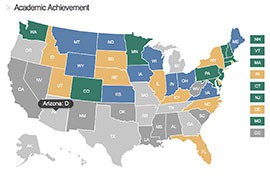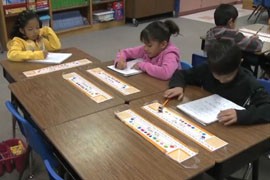Cronkite News has moved to a new home at cronkitenews.azpbs.org. Use this site to search archives from 2011 to May 2015. You can search the new site for current stories.
National report card gives state’s schools a D for academics
WASHINGTON – Arizona schools got a ‘D’ for their overall academic achievement on a national report card released Thursday by the U.S. Chamber of Commerce Foundation.
“Leaders and Laggards: A State-by-State Report Card on K-12 Educational Effectiveness,” graded states on how well their schools are performing and how well prepared students are for today’s job market.
The report, based on 2013 data, showed slight improvement for all states since the first report was released in 2007. Despite gains, however, the picture was still grim.
Arizona was one of 20 states and the District of Columbia to get a D or worse for their students’ academic achievement in the new report. And the U.S. as a whole continued to trail other nations on standardized test results, the report said.
Arizona school officials could not be reached to comment on the results Thursday, but other groups that work with schools in the state were not surprised by the grade.
“I see that this is our reality,” said Eileen Sigmund, president and CEO of Arizona Charter Schools Association. She wondered if the scores show that schools are “doing a disservice to our students, ultimately our state.”
A spokesman for the Arizona Chamber of Commerce and Industry said the national report reflects the concerns of the state’s business community – concerns that some groups in the state are working to fix.
“The business community understands some of the concerns that were raised in the ‘Leaders and Laggards’ report, but we’re not just sitting on our hands,” said Garrick Taylor, the state chamber spokesman. “We are doing something about it.”
The report is an issue for the chamber, he said, because it means employers are having trouble finding qualified applicants for jobs.
Workforce readiness was just one of several areas assessed in the report, from parental choice to finances to return on investment.
The academic achievement category was based on math and reading proficiency exams taken by fourth- and eighth-grade students, and comparing the 2013 averages with the percentage change in those scores from the 2007 report.
In Arizona, fewer than 30 percent of students were deemed proficient on the National Assessment of Educational Progress reading tests for fourth- and eighth-graders in the new report. Nationally, the proficiency rate was 34 percent and 35 percent, respectively.
For the math exam, 40 percent of Arizona fourth-graders were proficient, 2 percentage points below the national average; 31 percent of the state’s eighth-graders were proficient, 3 percentage points below the nation.
Taylor said the chamber has become active in education reform because it can open the door to economic development in the state.
“A high-performing education system will lead to greater job growth, which will in turn lead to a healthier economy,” he said.
Taylor pointed to “A for Arizona,” an initiative of the chamber and the Tucson Hispanic Chamber of Commerce to increase the number of top-performing low-income schools in the state. It is aimed at those schools that have “rejected the claim that their demography is destiny and have instead chosen to be excellent,” Taylor said.
Sigmund said teachers have the ability to change things.
“I think our first line of defense is teachers,” Sigmund said. “That is ultimately who is going to be making the difference for our students.”
Arizona did get an ‘A’ in the parental options category, which looked at how much control parents have over their child’s education.
Sigmund said she still finds hope in what schools can do to better prepare students for the workforce.
“I think we are starting to see a lot more cohesion towards a comprehensive solution,” she said.








